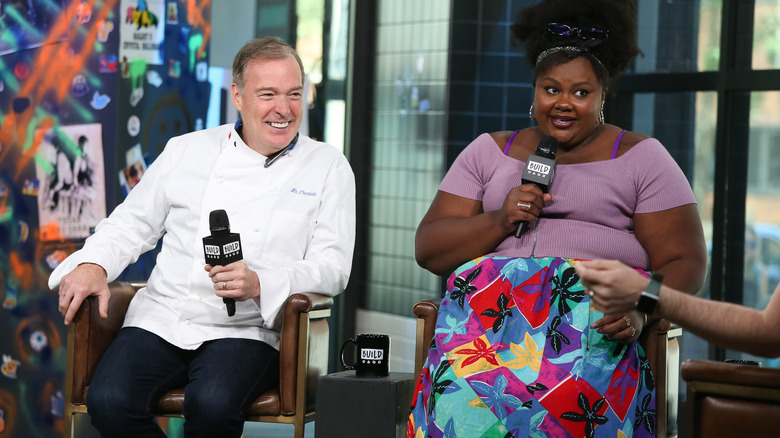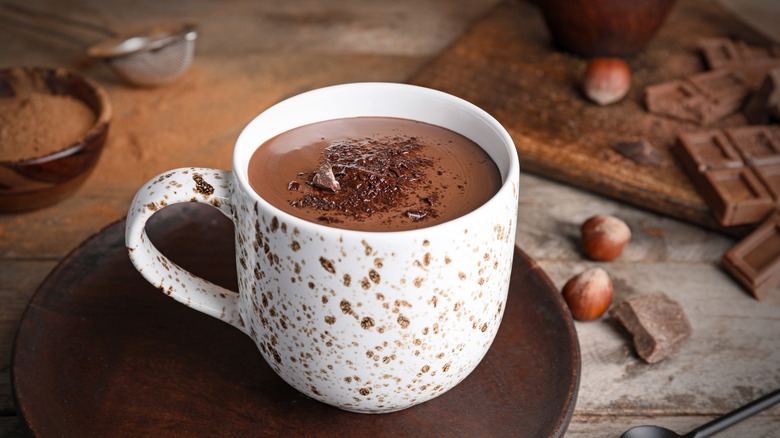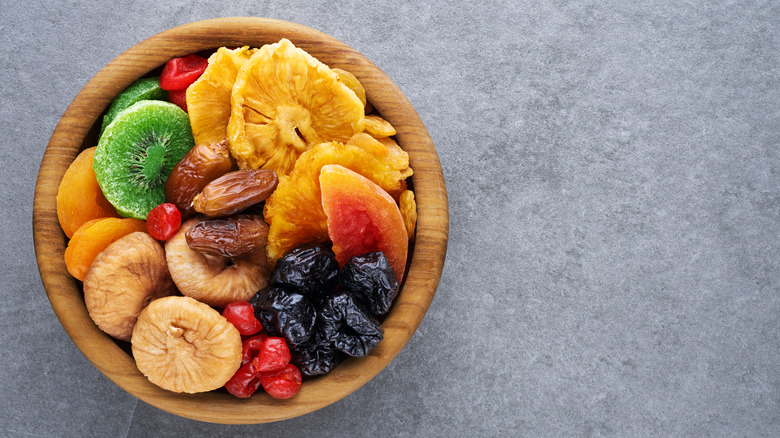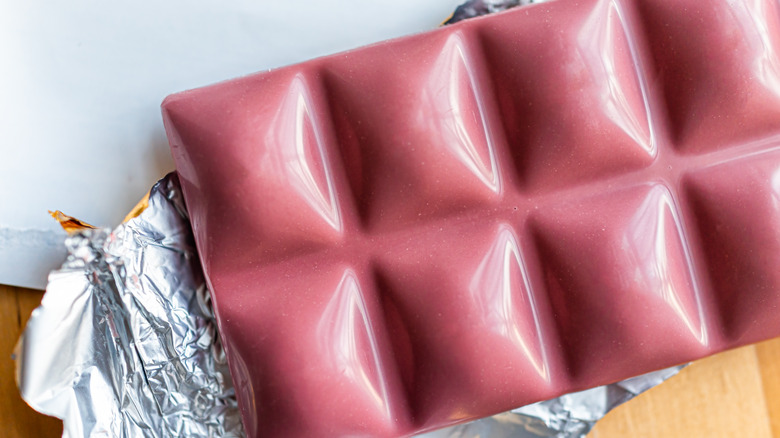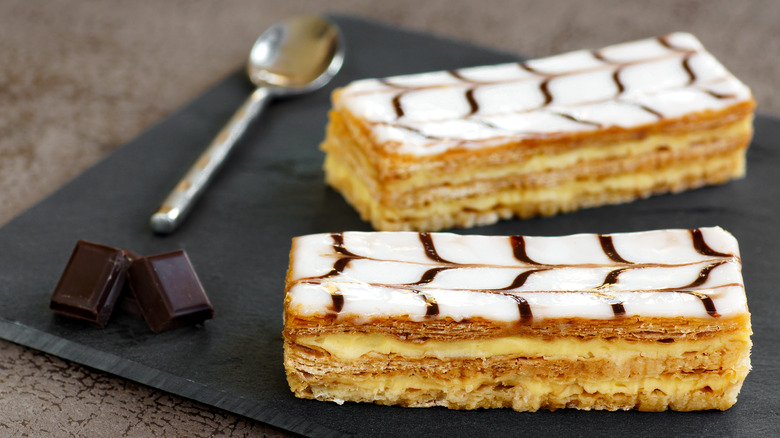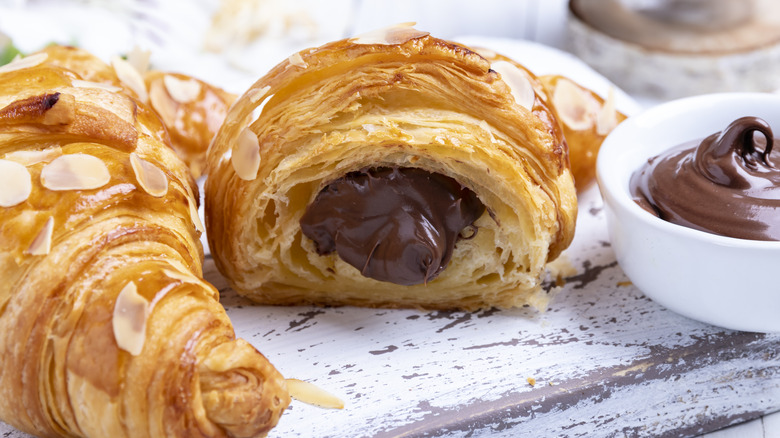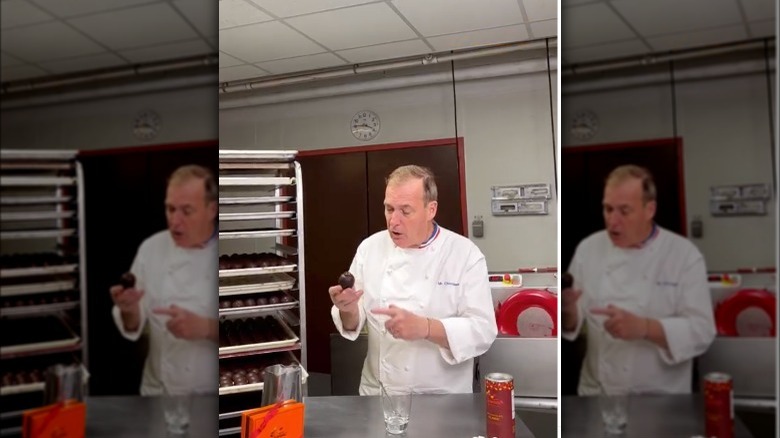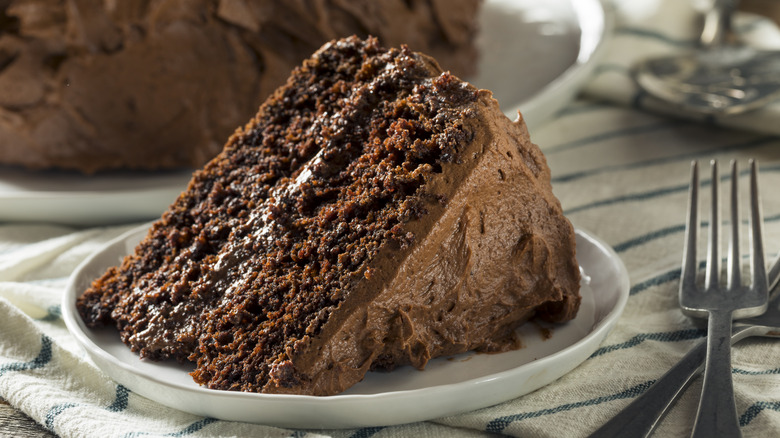Jacques Torres Discloses His Best-Kept Chocolate Tips And Tricks - Exclusive Interview
You surely know the name Jacques Torres — and if you don't, you may recognize it on your favorite chocolate bars. The famous pastry chef is known for his world-renowned gourmet chocolate line that offers everything from assorted bonbons to giant chocolate Santas. If that doesn't say the perfect holiday hosting gift, we don't know what does.
In an exclusive interview with Tasting Table, Torres shared his most beloved chocolate secrets so that you can get the perfect hot chocolate or chocolate croissant this winter. The "Nailed It" judge also revealed his criteria for a good pastry or dessert and divulged the most epic baking fails from the show. In the spirit of the holidays ramping up, he told us his best tips for pretzel mint bark and divulged the latest addition to his online store — hot chocolate bombs. The French chocolatier even named the most underrated pastry in the U.S. and how he really feels about that ruby chocolate trend.
The worst baking fails on Nailed It!
With your judging on "Nailed It!," what is the worst baking fail you have witnessed thus far while judging on the show?
Oh my God. Where do I start? Look, we have equal fails, equal catastrophes, because competitors or bakers forget the time. They play, they remember there is a camera, they talk to the camera, they take their time — and in the last 10 minutes, they pile buttercream onto a warm cake. Everything melts; everything colors up. They cannot decorate it. They don't have enough time. They get dirty. They have color everywhere.
That's what makes the show so funny, because people are not ready. They don't get ready to bake, they don't make a plan, they don't think about what's happening, and they end up with a catastrophe, which is very funny.
It is very fun. As a master pastry chef, what are the top three criteria that go through your head when judging a pastry or dessert?
I will look at the person's ability to plan. Being a pastry chef or baking is not like buying a piece of meat or buying some pasta, where you just cook it and serve it. It is very different. You have to make a plan. You need to strategize before you start so you know exactly where you're going. Things take time in baking, and not only that, one thing depends on the other.
Let's say you make a cake. You have to make the cake — the parts of the cake. Then you need to make the cream. Then you need to assemble the cake with that cream. You have to have a good foundation. Then you have to cover it with fondant, chocolate, whatever. Then you have to decorate it.
Every stage depends on the stage before. If you mess up the stage before, the next one isn't going to go so well. It's not that easy. You already have to plan, be organized, [and] be clean — and hopefully, you're going to end up with something good.
With cooking, you can throw stuff in and it'll taste good, but baking is much more precise.
Correct. You get it.
How to make the perfect hot chocolate
With winter rounding the corner, what do you think is the biggest mistake people make with hot chocolate?
The first thing is most people don't understand that hot cocoa is not hot chocolate, and hot chocolate is not hot cocoa. Hot cocoa is basically cacao that you mix with milk, and you add sugar. But people need to understand cacao is a byproduct of making chocolates. When you make chocolate, you need to add cocoa butter. In order to extract the cocoa butter from the plant, you need to compress the nibs; the cocoa butter runs and the leftover — the dry portion — is the cacao.
Some companies trash it. Some companies sell it as cacao or cocoa, and it's a byproduct of extracting cocoa butter. It's not really a finished product. It's pretty much ... maybe not raw because the cacao beans were toasted, but it's an unfinished product. Now, when you put chocolate into milk, finished chocolate into milk, this is a finished product. My guess is that people make mistakes by using one for the other and hot cocoa. Hot cocoa is not as good as hot chocolate or hot nib chocolate.
That's one of the fundamental mistakes that people will make. After that, if you put mint candy cane, if you put spices, whatever you're going to put in it — be careful of the balance of flavor. You don't want to be overpowering, but you still want to feel it. I love ancho and chipotle chili; that cannot be overwhelming either. It has to be just a hint of it, so you feel it, but it's not overwhelming. [It's the] same for mint or holiday spices. It has to be well-balanced.
Absolutely. I saw on your Instagram that we rated your hot chocolate number one.
I was very pleased with that. Thank you.
Add dried fruit to your pretzel mint bark
You offer a pretzel mint bark on your website. Do you have any favorite additions to that treat besides pretzels?
The bark is interesting. The bark is a product that you're going to mix different things with chocolates — milk or dark — and then you're going to break [it] in pieces to offer to your guests. I love the fact that we break it because it's a little bit like sharing bread. That comes from a very long line ... You share bread at the table — Spanish family, Italian family, French. We love to share bread. Coming from this idea, I started to make bark because we share a piece of a dessert; we share a piece of chocolates.
After that, you can put pretty much anything you want into the bark. You can put nuts, you can put dry fruits, you can put seeds, you can put bread sauce, mint. There are a lot of things that you can do with it. I like the classics. I like dark chocolate oatmeal chocolates with nuts — this is my favorite one. For the holiday, we will do the peppermint bark. We will do some different things. But I like the one with the nuts. I like classic flavors.
I do too. The dried fruit was interesting. Does that make it sweeter or more bitter? How does that complement the chocolate?
It depends on what foods you're going to use. Are those foods being sweetened or not? When you buy cranberries, a lot of the time the cranberry was sweetened, because cranberries are very acidic. They're very bitter. If the food was not sweetened, then yes, you're going to have maybe more flavor, a little bit less sweetness. But if you use raisins — if you use dry apricots, dry mango, dry peaches — that brings some sweetness to it, but also extra flavor, which is always good.
I love the extra flavor. I like to cut my food a little bit smaller. You don't want to heat a big piece of apricot, and it's a little bit hard and you have to chew that for a long time. I like to cut them a little bit smaller for ease of eating.
How Torres feels about ruby chocolate
This summer, I was traveling a bit and got the opportunity to try ruby chocolate. What's your opinion on ruby chocolate as a whole?
It's almost like fashion. Things come in, and suddenly they come out. Ruby chocolate made a lot of noise when it came in, but I don't hear any more about it. Maybe people are using it a lot; I don't know. But there is no more buzz about it.
To me, ruby chocolate is white chocolate with a little bit more flavor. It's a little bit more marketing and fashion than the real discovery. Again, this is my guess — I never fell into the wagon of doing things with it. I stay away from it. I tasted it. I like the fruitiness of it. It was a little bit sweet, so I stay away from it.
How do you feel about coating chocolate? Do you recommend it, or do you prefer tempered chocolate? What do you normally like?
That's a very good and interesting question. Most of the time, coating chocolates don't contain cocoa butter. Cocoa butter is why you temper chocolate. Cocoa butter is unstable, so to use chocolate with cocoa butter, you're going to have to temper it. Coating chocolates have different fats that are stable, and they don't break down when you melt your chocolates.
The problem with most of that fat is it's going to melt at a higher temperature than your body temperature. That means that when you melt it, or when you let that chocolate melt in your mouth [with] that coating chocolate, that coating chocolate is going to coat your taste bud and have that feeling of waxiness. That's where the expression, "Oh, this chocolate is waxy" [comes from]. There is no wax in chocolates — none. But it can be a feeling of waxiness, like, "Oh my God, this feels like there is wax in this chocolate, because my taste buds get coated." That's what's happens with coating chocolates.
[With] real chocolate, the cocoa butter will melt under your body temperature and will slide, and you will not have this type of feeling. If you ask me which one I prefer, I prefer real chocolate, because I don't get that waxy feeling after eating chocolates.
On "Nailed it!," do they normally use coating chocolate? I know you use it for cake pops and stuff like that.
We rarely use real chocolate. The reason is that in the time that you have, people will not be able to temper. In the past, we used coating chocolates — we did not use real chocolates. It's because of time constraints. Also, most people don't know anything about tempering chocolates.
If you see some of the videos I do now, I temper chocolate actually very fast. I put it in a microwave, melt it two-thirds — so I still have some pieces in it — and right away, I pour it when it comes out of the microwave into a room-temperature bowl so it stops melting. [I take an] immersion blender, mix it, and usually, the chocolate is tempered. I can temper chocolates as I talk for a demonstration at the same time. It's relatively easy. It's just a question of knowing how to do it. That's all it takes.
The underrated pastries in the U.S.
Is there one French pastry that you feel the United States doesn't necessarily have or maybe should have more of?
When I came to this country almost 35 years ago, there was a lot of pastry that we could not find. Today, we find a lot of French pastries in the U.S. — French, Italian, whatever country. The culinary world in America really grew, maybe even more during that period than it grew in France. It grew a lot because we were behind.
Now, can you find a very good Napoleon — or what we call a Mille-Feuille, which is the Napoleon? Most of the time, no. But even in France, most of the time, it's not made the classical way, the good way. Some bakers don't take the time to make it the classical way. To me, it's not a question of, "Am I going to find a Napoleon in a bakery?" It's, "Am I going to find a good Napoleon in a bakery?" That's where things become a little bit more touchy.
If you talk about that, we can say the same thing for the éclair. We can say the same thing for a tart or pie. I like [them] classically well done. I don't like those shortcuts —you see a lot of the shortcuts on TikTok and all those social media. It doesn't always work well. Pastry takes time. The caramelization of the dough in the oven, the finishing, the glaze, the beautiful foods — there are no tricks to make it go in two minutes.
Torres' tips for a chocolate croissant
What would you say is the secret to the perfect chocolate croissant?
The secret is time. I read lately that around 80% of the bakeries in France buy their croissants frozen from the factory. I find that very interesting because it's an art that we are losing. The secret is time; you cannot use fast-acting yeast. You need to make them with a regular yeast and give time to the dough to ferment slowly, because that's going to give the flavor.
What's the flavor of a croissant? You have three things. You have fermentation — that's the yeast that's going to give flavor, and that's going to happen with time. Then you have the butter; we have wonderful butter in France. You need to use a good butter that has that good flavor. The third thing is caramelization. You need to put your croissants in the oven and give them color. That color, [which] is the color in the croissant, is the sugar caramelizing. That is to bring flavor.
[It's] fermentation, butter, and caramelization. Time is very important, because that's what is going to give the fermentation flavor. I make croissants in my factory. I have croissants now that I make, but I make them for my family because finding a good croissant is difficult. But if you look at social media, you see more and more young pastry chefs doing all those specialties with croissant dough. They will take the croissant dough and turn it into something completely different. I like that, because that means they make the dough. They go all the way to making the product, and I do like that. We start to have a renaissance of pastry chefs making those products.
If you had to give someone making a chocolate croissant a tip for the first time, what would your first tip be?
Putting [enough] chocolates in it, because it's first a chocolate croissant. The first word is chocolate. It's like chocolate chip cookies. Put good chocolates — and enough of it — into the chocolate chip cookies. Put enough of it and put good quality chocolate.
You cannot make a very good strawberry tart with bad strawberries. You cannot make a very good pale chocolate, chocolate croissant, or even a chocolate chip cookie with bad chocolates. You use a good product. It's interesting to me that if you go to the supermarket and you buy those chips — I think it's called Toll House?
Yes. Nestlé Toll House.
Those chips, you put them in the cookie dough and you put that in the oven. The oven is going to be at around 350 degrees. When you take those cookies out of the oven, the chips have the same shape. They didn't melt. Now the question is, if the chocolate chips don't melt at 350 degrees, what's going to happen in your stomach at less than 100 degrees?
That's a good point.
There is not enough cocoa butter. Not melting chocolates is the [lack of] cocoa butter.
Torres is offering hot chocolate bombs
On your Instagram, you were creating some chocolate trees and hot chocolate bombs for the holidays. Are there any other festive offerings that are coming to your gourmet chocolate brand that people can be excited for?
No, other than doing what we do the best possible way. About the bomb, I didn't want to do those things because they are really labor intensive. But my customers asked for them. I said, "Okay, fine, I'm going to make them." I start tasting bombs from different places, and I realized that what people do is they take chocolates — good or bad chocolate, whatever — and they mold it into a ball with something inside.
I decided to do something different. I take my hot chocolate mix that contains milk, powder, spices, different things, and I melt that hot chocolate mix. My bombs are made with hot chocolate mix and not just plain chocolates, so when you melt it in milk, it is a hot chocolate. It's not just melted chocolates. I have extra things in it to make it more creamy, more flavorful. There's a difference.
Torres is working on a nationwide chocolate cake
What would you say is your favorite holiday dessert and why?
I don't know if I can come down to one dessert. I like classy, so if you ask me about Christmas, I will say I like the Christmas log ... Bûche de Noël, Yule. I like that because I am going to make them once a year. I'm going to eat them once a year, and I don't eat them until next year. I don't make them again. It's one of those cakes that's once a year.
Lately, a couple of weeks ago, I went to eat at a friend's house and I brought some circles of puff pastry — very simple, good, real butter puff pastry. When I was in their place, I put a little pastry cream on them, and I put a thin layer of apples, about one apple per ring. I baked them for five to 10 minutes. Then I flipped the apple down and the dough up. Now in the oven, the apples are baking on the bottom. They don't dry because there is the dough on top, and the dough becomes very crunchy because there is nothing on top to make it wet.
I glazed it with a little bit of sugar, and I serve those little thin tarts with vanilla ice cream. Something that simple, if it's well done, is delicious. Nobody takes time to do those things. It takes time to put them together before dinner. You have to flip them, and you need to finish baking them, and you need to glaze them with sugar. Then you put a little ice cream on top. But oh my God, when you eat that, it's so good.
That's the kind of desserts that I would love. It's made for the table. It's made for you. That's the kind of experience that you will get if you go to a restaurant where there is a good pastry chef and they do something for your table, the attention [to detail].
Do you have any upcoming projects or anything else exciting coming up that you would be willing to share?
Usually what I do here in my business ... Now, I help in production, because it's the holiday. Otherwise, I do research and development and I slow myself down. I don't put too many new things out, because every time you put something new, you need packaging, you need advertisement, you need social media ... You need so many things now in business to put a new product.
I do my R&D [research and development], and from time to time, like the bomb, we decide to put them out. I'm working on a chocolate cake that maybe we can ship. I'm working on different little ideas like that. I don't know when that is going to come to maturity — I have no idea. Hopefully, chocolate cake would be one of the next things.
Head to Jacques Torres' chocolate website to check out his latest offerings.
This interview has been edited for clarity.

